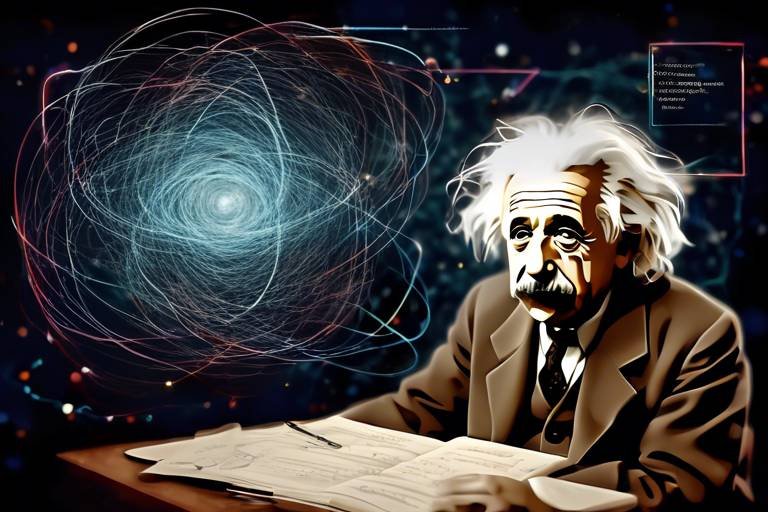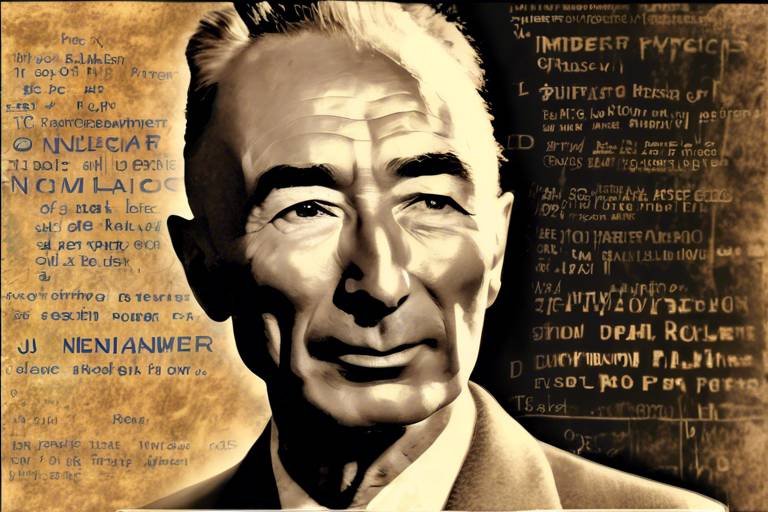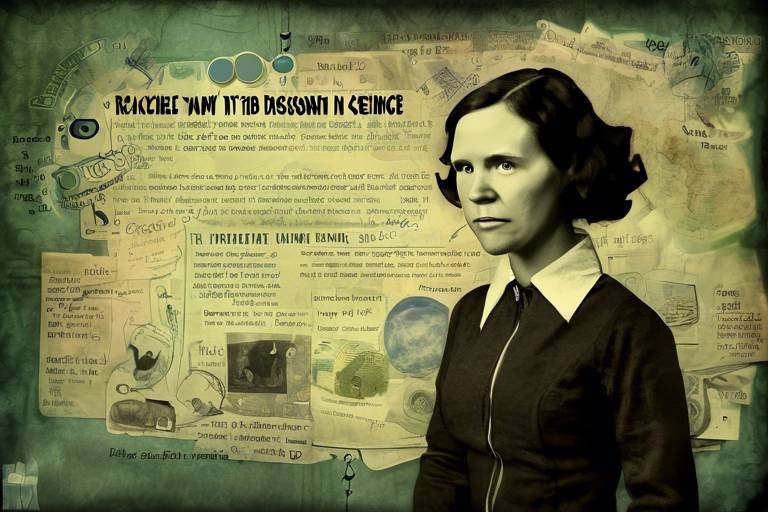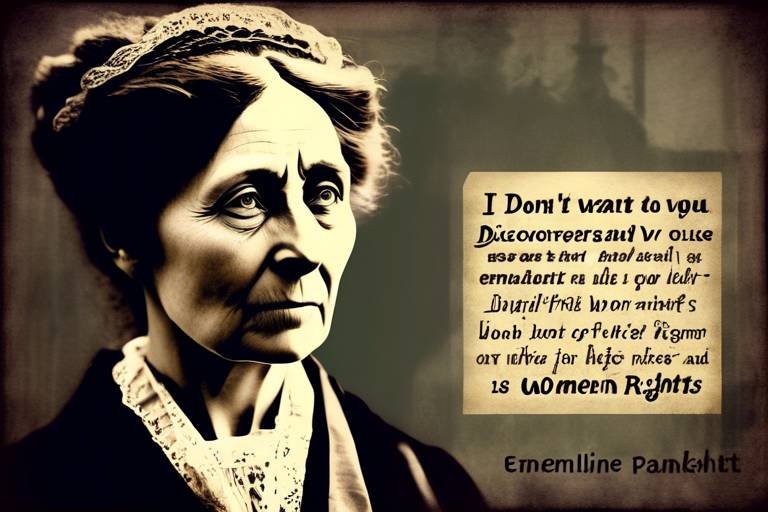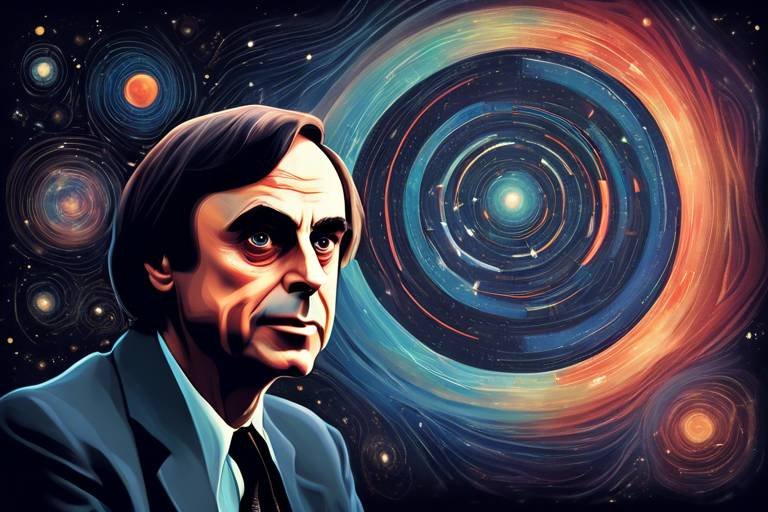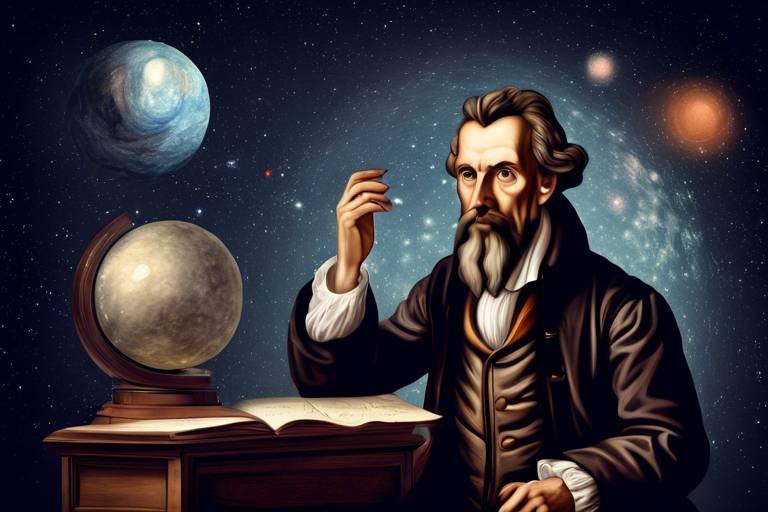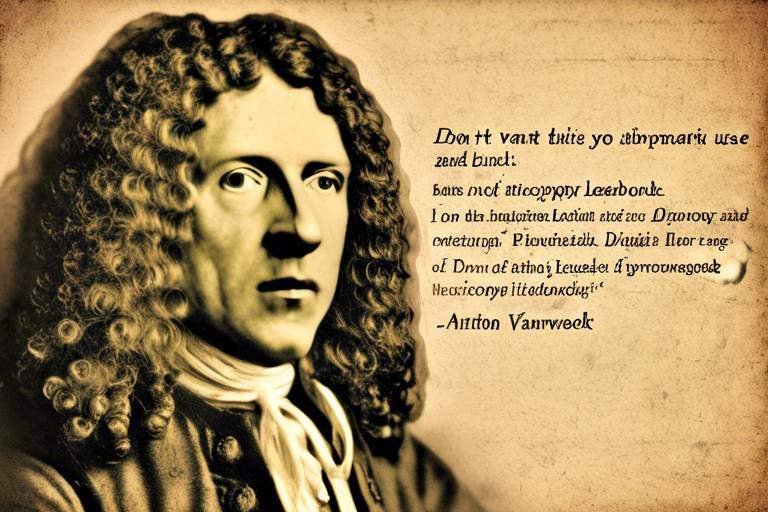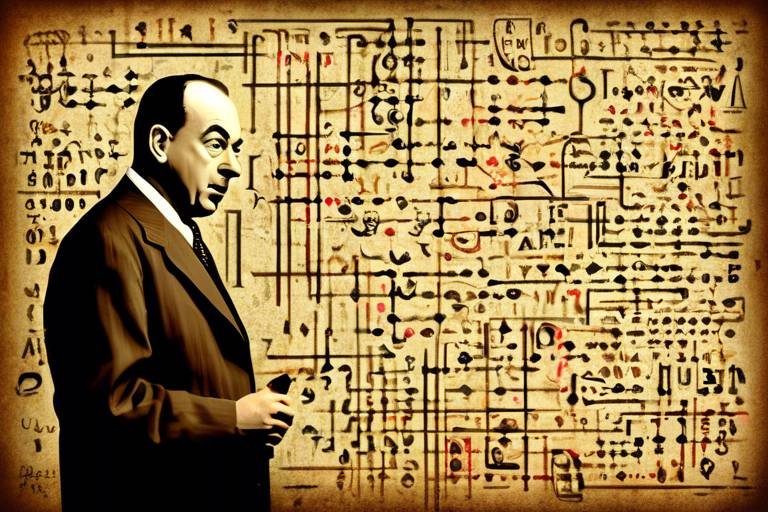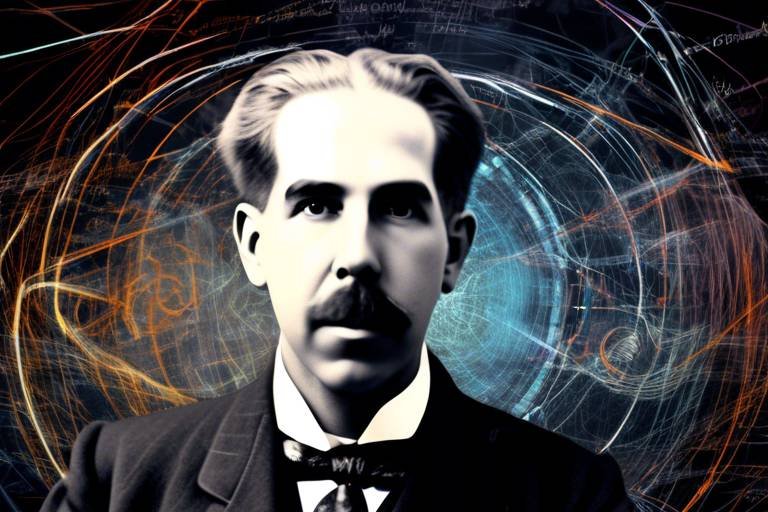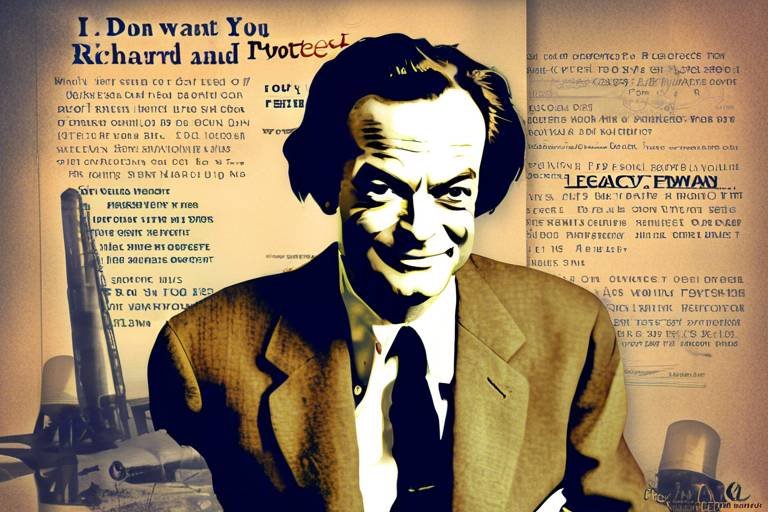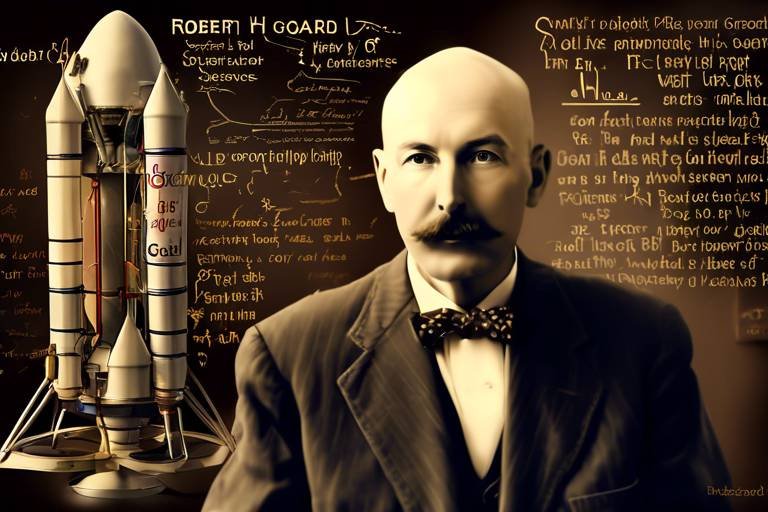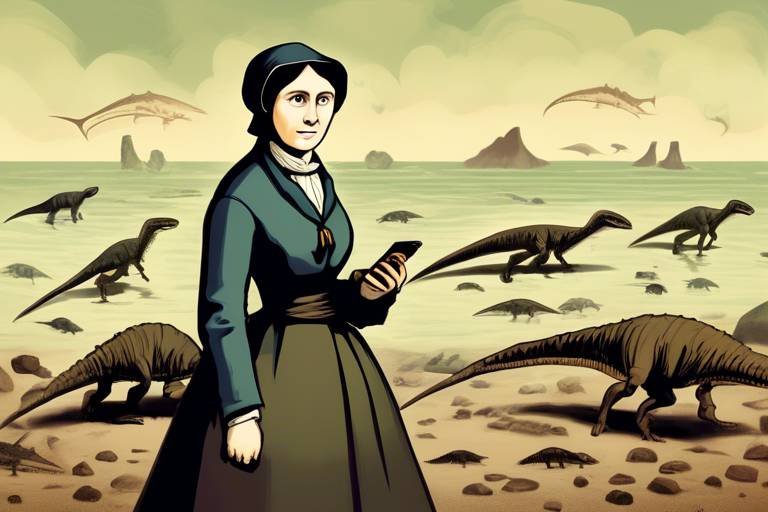The Life of Albert Einstein and Theoretical Physics
Albert Einstein, a name synonymous with genius, revolutionized our understanding of the universe through his groundbreaking theories in theoretical physics. Born on March 14, 1879, in Ulm, Germany, his journey from a curious child to a monumental figure in science is nothing short of extraordinary. With a mind that challenged the status quo, Einstein's contributions have not only reshaped physics but have also ignited a passion for science in countless individuals around the world. His theories of relativity, specifically the special and general theories, have fundamentally altered how we perceive time, space, and gravity. Imagine a world where time is not a constant, but a variable that can stretch and contract! That’s precisely what Einstein proposed, and it opened the door to a new era of scientific inquiry.
Einstein's life is a testament to the power of imagination and inquiry. He often said, "Imagination is more important than knowledge." This philosophy guided him through his early years, where he displayed a keen interest in mathematics and physics, often questioning the conventional wisdom of his time. His education was not without challenges; he faced obstacles in his schooling, yet he transformed these hurdles into stepping stones towards his illustrious career. It’s fascinating to think that a young boy, who struggled in school, would grow up to become one of the most influential scientists in history.
Throughout his life, Einstein remained a curious explorer of the universe. His theories did not emerge in isolation; they were the result of a deep-seated desire to understand the fundamental laws governing our reality. From his early works to his later contributions, Einstein's life was marked by an insatiable quest for knowledge. His ability to simplify complex concepts into relatable ideas is what makes his work so accessible even today. For instance, when he introduced the concept of light being both a particle and a wave, he was essentially asking us to rethink everything we thought we knew about light. This kind of radical thinking is what set him apart from his contemporaries.
As we delve deeper into his life and contributions, we uncover not just a scientist, but a humanitarian who advocated for peace and social justice. Einstein was not only concerned with the mechanics of the universe but also with the well-being of humanity. His legacy extends beyond the realm of physics; it serves as a reminder of the responsibility that comes with knowledge. In a world where science and ethics often clash, Einstein's life encourages us to use our understanding of the universe to foster a better world.
In conclusion, the life of Albert Einstein is a remarkable journey of intellectual discovery and humanitarian advocacy. His groundbreaking theories in theoretical physics have forever changed our understanding of the universe, challenging us to think beyond the conventional. As we continue to explore the mysteries of the cosmos, we carry forward the spirit of inquiry that Einstein embodied. His legacy is not just in the equations he formulated but in the inspiration he ignites in each of us to question, to explore, and to dream.
- What is Einstein's most famous equation? Einstein's most famous equation is Emc², which expresses the equivalence of mass and energy.
- What did Einstein mean by relativity? Relativity refers to the way space and time are interconnected, fundamentally changing how we understand motion and gravity.
- How did Einstein contribute to quantum mechanics? Although he had reservations about quantum mechanics, Einstein contributed to its development, particularly through his work on the photoelectric effect.
- What was Einstein's view on peace? Einstein was a passionate advocate for peace and often spoke out against war and violence, emphasizing the need for global cooperation.

Early Life and Education
Albert Einstein was born on March 14, 1879, in the vibrant city of Ulm, in the Kingdom of Württemberg, Germany. From a young age, he exhibited a keen interest in understanding the world around him. His parents, Hermann and Pauline Einstein, played a significant role in nurturing his curiosity. They encouraged him to explore various subjects, which laid the groundwork for his future intellectual pursuits. It’s fascinating how a child’s inquisitive nature can blossom into groundbreaking theories that reshape our understanding of the universe, isn’t it?
Einstein's education began at a local primary school, where he often found himself at odds with the rigid educational system. He was not a fan of rote learning and preferred to engage in discussions and debates. This early resistance to conventional teaching methods would later fuel his innovative thinking. In 1885, his family moved to Munich, where he attended the Luitpold Gymnasium. However, he struggled with the strict discipline imposed by the school, leading to a rather tumultuous academic experience.
By the age of 16, Einstein had already developed a profound love for mathematics and physics. He was particularly captivated by the works of renowned scientists like Isaac Newton and James Clerk Maxwell. In pursuit of his passion, he decided to leave Germany and move to Switzerland to attend the Polytechnic Institute in Zurich. Here, he found an environment that encouraged creativity and critical thinking, allowing his genius to flourish.
At the Polytechnic Institute, Einstein faced challenges, especially in his early years. He struggled with some subjects, particularly languages, but excelled in mathematics and physics. This dichotomy in his academic performance is a testament to the idea that genius often comes with its own set of challenges. It’s like being a puzzle piece that doesn't quite fit into the conventional picture. After graduating in 1900, he faced a tough job market and found himself working as a patent examiner at the Swiss Patent Office in Bern.
Despite the seemingly mundane job, this period proved to be crucial for Einstein. He utilized his spare time to delve deeper into theoretical physics, developing ideas that would eventually lead to his groundbreaking theories. His experience in the patent office allowed him to think critically about various scientific concepts, further honing his analytical skills. It’s almost poetic how a job that many would consider ordinary became the backdrop for extraordinary thoughts that would change the course of science.
In summary, Einstein's early life and education were marked by a blend of curiosity, rebellion against conventional education, and a relentless pursuit of knowledge. These formative experiences shaped his innovative mindset and set the stage for his future contributions to physics. The journey from a curious child in Ulm to a revolutionary thinker in Zurich is a testament to the power of education and the importance of nurturing one’s passions.
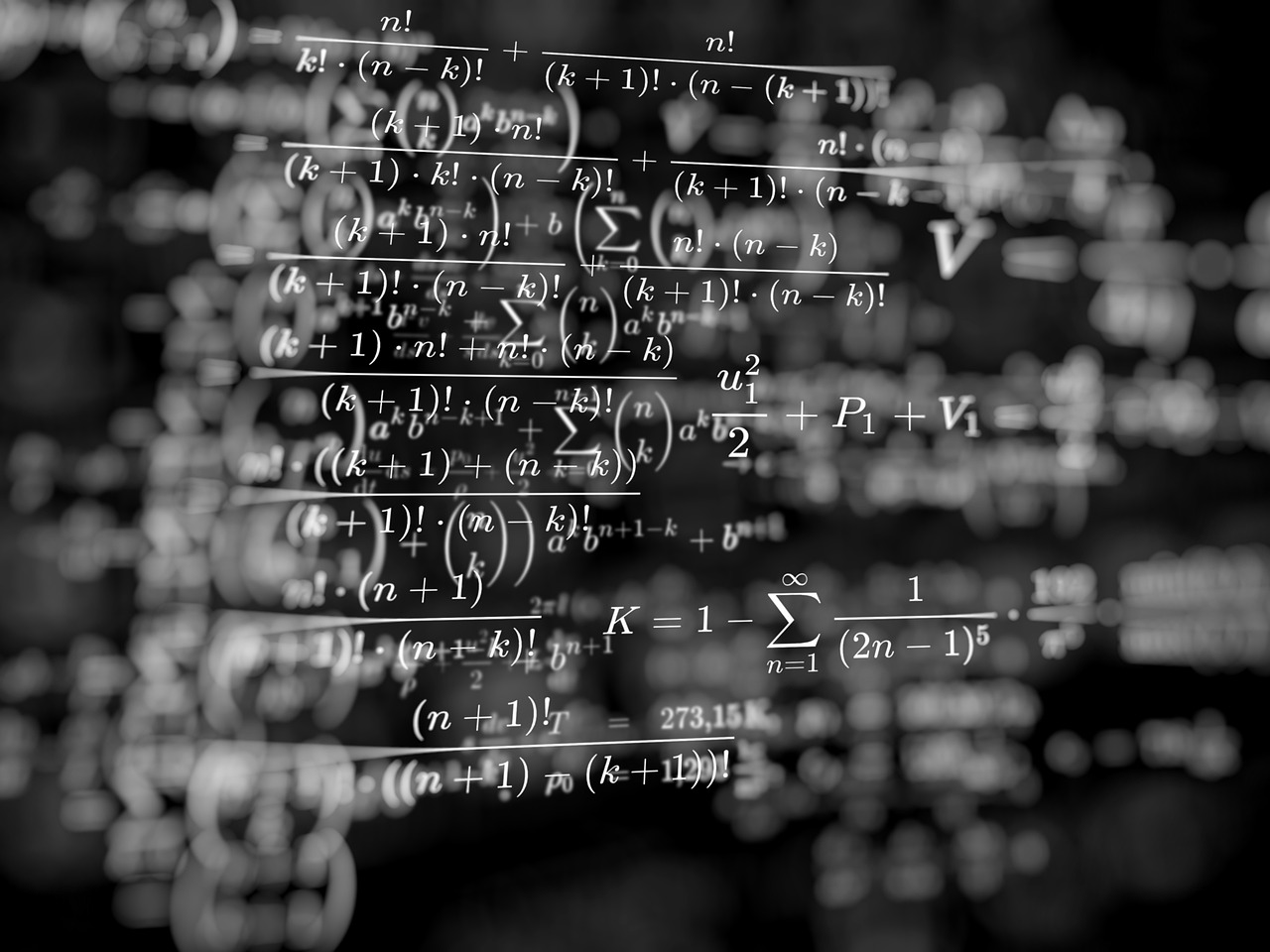
Relativity: The Game Changer
When you hear the term relativity, what comes to mind? For many, it conjures images of a wild-haired scientist scribbling equations on a chalkboard. But *relativity* is so much more than that; it is a profound shift in our understanding of the universe. Albert Einstein's theory of relativity, introduced in the early 20th century, fundamentally changed the way we perceive space and time. His groundbreaking ideas challenged the status quo and opened the door to new realms of physics that continue to shape our world today.
Einstein's theory can be divided into two parts: special relativity and general relativity. Each plays a crucial role in our understanding of the cosmos and offers insights that are as mind-bending as they are revolutionary. Let's dive deeper into these concepts and see how they transformed the landscape of physics.
Introduced in 1905, special relativity was a game changer in its own right. It brought forth ideas that seemed almost fantastical at the time. Imagine a world where time is not a constant but can stretch and contract based on your speed. This is the essence of time dilation, one of the most intriguing aspects of special relativity. Einstein's famous equation, Emc², emerged from this theory, establishing a relationship between mass and energy that has profound implications for everything from nuclear power to the very fabric of matter.
So, what is time dilation? Picture this: two twins, one stays on Earth while the other travels in a spaceship at near-light speed. When the traveling twin returns, they find they have aged less than their sibling. This isn’t just science fiction; it’s a consequence of special relativity. The faster you move through space, the slower you move through time. This concept has real-world applications, especially in technologies like GPS, which must account for time dilation to provide accurate positioning.
Now, let’s talk about mass-energy equivalence. The equation Emc² is not just a catchy phrase; it encapsulates a revolutionary idea: mass can be converted into energy and vice versa. This principle underpins the workings of nuclear reactors and atomic bombs. It’s like realizing that the tiny bits of matter around us are brimming with energy just waiting to be unleashed. This realization has transformed energy production and our understanding of the universe at a fundamental level.
If special relativity was a shock to the system, general relativity, published in 1915, was an earthquake. Einstein expanded upon his earlier work to introduce a radical new view of gravity. Instead of seeing gravity as a force acting at a distance, he proposed that it is the result of mass curving the fabric of space-time. Imagine placing a heavy ball on a trampoline; it creates a dip that pulls smaller balls towards it. This analogy helps illustrate how massive objects like planets warp space-time, creating what we perceive as gravity.
General relativity has been confirmed through numerous experiments and observations, from the bending of light around massive objects to the detection of gravitational waves. It reshaped our understanding of the universe, leading to predictions about black holes and the expansion of the universe itself.
In summary, Einstein's theories of relativity not only revolutionized physics but also changed our perception of reality. They challenge us to think differently about the very nature of time and space, pushing the boundaries of what we thought was possible. The implications of these theories continue to ripple through the scientific community, inspiring new generations of physicists to explore the mysteries of the cosmos.
- What is the main idea behind special relativity? Special relativity proposes that the laws of physics are the same for all observers, regardless of their relative motion, and introduces the concept of time dilation.
- How did general relativity change our understanding of gravity? General relativity describes gravity not as a force but as a curvature of space-time caused by mass, fundamentally altering our view of how objects interact in the universe.
- What are some practical applications of relativity? Relativity has practical applications in technologies such as GPS, nuclear energy, and even in understanding the behavior of particles in accelerators.
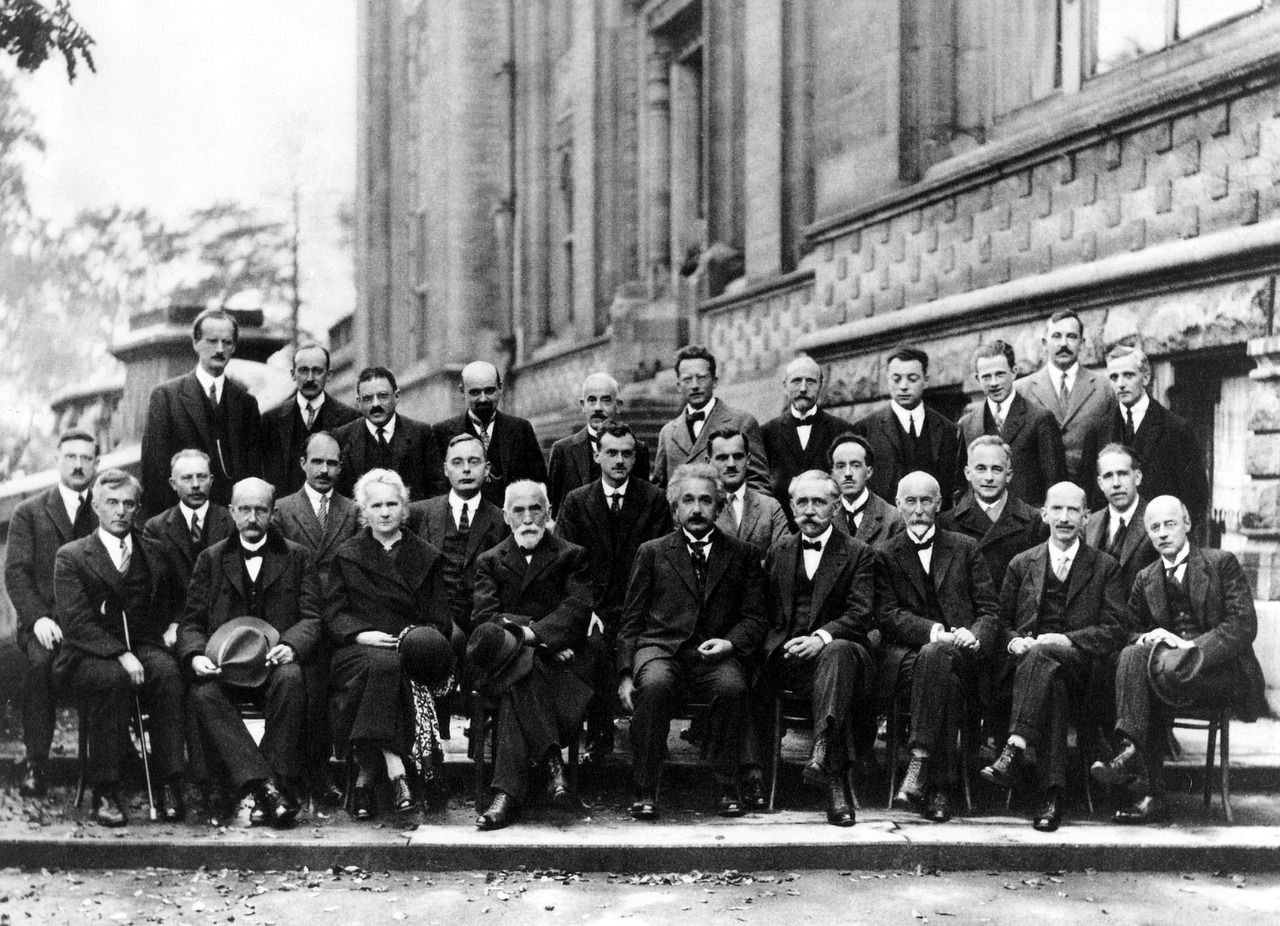
Special Relativity
is one of the most groundbreaking theories in the realm of physics, introduced by Albert Einstein in 1905. This theory fundamentally altered our understanding of the relationship between space and time, challenging long-held beliefs that had persisted for centuries. Before Einstein, space and time were viewed as absolute entities, existing independently of one another. However, with his revolutionary ideas, he showed that they are interwoven into a single continuum known as space-time.
At the heart of special relativity are two postulates that Einstein proposed:
- The laws of physics are the same for all observers, regardless of their relative motion.
- The speed of light in a vacuum is constant and will always be the same, regardless of the motion of the light source or observer.
These principles led to some astonishing conclusions. For instance, one of the most famous outcomes of special relativity is the concept of time dilation. Imagine you’re on a spaceship traveling close to the speed of light, while your twin stays on Earth. When you return, you would find that your twin has aged significantly more than you! This isn't just a sci-fi scenario; it’s a real effect that has been confirmed through experiments with atomic clocks on fast-moving jets. It’s as if time itself is a rubber band, stretching and compressing based on speed.
Another monumental aspect of special relativity is the equation Emc², which expresses the equivalence of mass and energy. This equation implies that a small amount of mass can be converted into a tremendous amount of energy, laying the groundwork for nuclear energy and even the understanding of stellar phenomena. Just think about it: the energy produced by the sun comes from the conversion of mass through nuclear fusion. This tiny equation encapsulates the power of the universe in a simple formula!
The implications of special relativity extend beyond theoretical physics; they have practical applications as well. For example, the Global Positioning System (GPS) satellites orbiting Earth must account for both the effects of special relativity and general relativity to provide accurate location data. Without these adjustments, our GPS devices would lead us astray, showing us positions that could be off by several kilometers over time.
In summary, special relativity is not just a theory; it’s a profound shift in our understanding of the universe. By revealing the interconnectedness of space and time, Einstein opened the door to modern physics, inspiring generations of scientists to explore the mysteries of the cosmos. His work reminds us that the universe is more complex than it appears at first glance, urging us to keep questioning and exploring.
- What is time dilation? Time dilation is the phenomenon where time passes at different rates depending on the relative speeds of observers. It means that a clock moving at a high speed will tick slower compared to a stationary clock.
- What does Emc² mean? This famous equation means that energy (E) is equal to mass (m) multiplied by the speed of light (c) squared. It shows that mass can be converted into energy and vice versa.
- How does special relativity affect GPS technology? GPS satellites experience both special and general relativity effects. Their high speeds and altitude affect the passage of time, necessitating adjustments to ensure accurate positioning on Earth.

Time Dilation Explained
Time dilation is one of those mind-bending concepts that can make you feel like you're living in a science fiction novel. Imagine you're on a spaceship, zooming through the cosmos at a speed close to that of light. Meanwhile, your friend is back on Earth, sipping coffee and watching the latest blockbuster. According to Einstein's theory of special relativity, time for you aboard the spaceship would pass more slowly than for your friend on Earth. This isn't just a quirky idea; it's a fundamental aspect of how our universe operates!
To put it simply, time dilation occurs because the speed of light is constant, no matter how fast you're moving. As you approach that cosmic speed limit, the time you experience slows down compared to someone who is stationary. This phenomenon has been confirmed through numerous experiments, including those involving atomic clocks on fast-moving jets. When these clocks are compared to stationary clocks on the ground, the results show that time indeed ticks differently based on speed. It's as if the universe is playing a cosmic game of hide-and-seek with time itself!
One of the most fascinating implications of time dilation is its impact on space travel. If humans were to embark on a journey to distant stars, those traveling at significant fractions of the speed of light could return to Earth only to find that many years, or even centuries, have passed for those who stayed behind. This opens up a Pandora's box of questions about aging, relationships, and the very fabric of time. It’s a little like being in a time machine, where your experiences are vastly different from those left on the planet.
To illustrate this concept further, let’s consider a simple table that compares the effects of time dilation at various speeds:
| Speed (as a fraction of the speed of light) | Time Experienced by Traveler (1 year) | Time Experienced on Earth |
|---|---|---|
| 0.5c | 1 year | 1.155 years |
| 0.8c | 1 year | 1.667 years |
| 0.9c | 1 year | 2.294 years |
| 0.99c | 1 year | 7.089 years |
This table highlights how the faster you travel, the more pronounced the effects of time dilation become. At 0.99 times the speed of light, a traveler experiences just one year, while over seven years pass for those on Earth! It's a staggering realization that challenges our intuitive understanding of time.
In conclusion, time dilation not only fascinates scientists but also sparks the imagination of storytellers and dreamers alike. It raises profound questions about the nature of reality and our place in the universe. As we continue to explore the cosmos, who knows what other secrets about time and space await us? So, the next time you glance at your watch, remember: time is not as straightforward as it seems!
- What is time dilation? Time dilation is the difference in the elapsed time as measured by two observers, due to a relative difference in velocity between them.
- How does speed affect time dilation? As an object's speed approaches the speed of light, time for that object slows down relative to a stationary observer.
- Are there real-world examples of time dilation? Yes, experiments with atomic clocks on fast-moving jets have confirmed the effects of time dilation.
- What are the implications of time dilation for space travel? Time dilation means astronauts traveling at high speeds could age slower than people on Earth, leading to potential challenges in long-distance space travel.
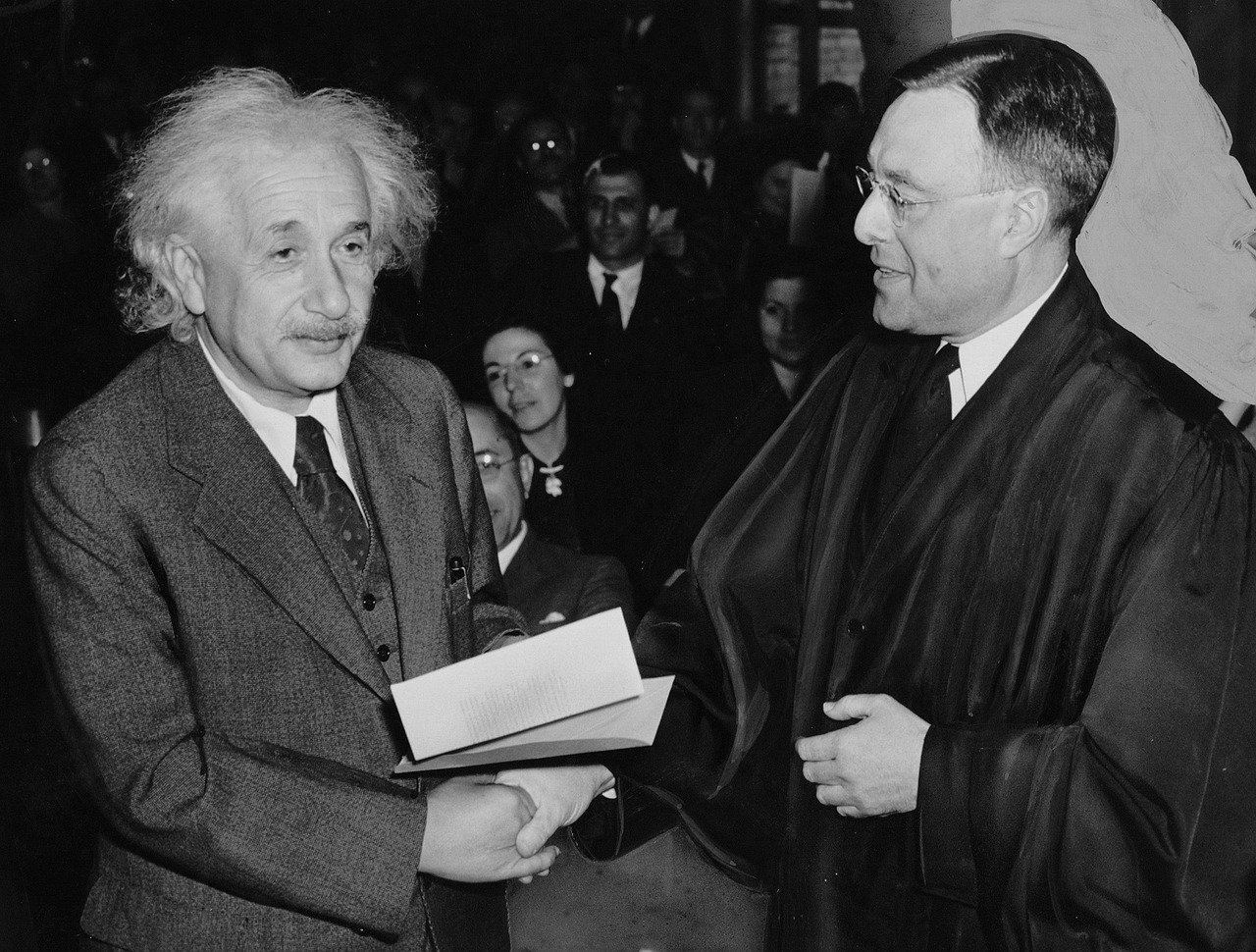
Mass-Energy Equivalence
At the heart of Einstein's groundbreaking work lies the astonishing concept of , encapsulated in the iconic equation Emc². This formula elegantly communicates that mass and energy are not distinct entities but rather two sides of the same coin. To put it simply, mass can be converted into energy and vice versa, fundamentally altering our comprehension of the physical world. Imagine a tiny pebble sitting on the ground; it may seem insignificant, but according to Einstein, even that pebble contains a vast amount of energy just waiting to be unleashed.
Einstein's revelation came at a time when the scientific community was grappling with the complexities of atomic structure and energy transformations. The implications of Emc² were profound, suggesting that even small amounts of mass could yield enormous energy. This principle is not merely theoretical; it has practical applications that have reshaped our world, particularly in the fields of nuclear physics and energy production. For instance, the energy released during nuclear fission in atomic bombs and nuclear reactors is a direct result of mass being converted into energy as described by Einstein's equation.
To better understand this concept, let's break it down:
- E: Represents energy
- m: Represents mass
- c: Represents the speed of light in a vacuum (approximately 299,792,458 meters per second)
The speed of light squared (c²) is a staggering number, which is why even a small amount of mass can produce a tremendous amount of energy. This relationship also paved the way for the development of technologies such as nuclear power plants, which harness this energy for electricity generation. However, it’s crucial to recognize the dual-edged nature of this discovery; while it has led to significant advancements, it also brought about the potential for devastating weapons.
Einstein himself was aware of the ethical implications of his work. He famously remarked, “The unleashed power of the atom has changed everything save our modes of thinking, and thus we drift toward unparalleled catastrophe.” This quote highlights the responsibility that comes with scientific discovery, reminding us that understanding the universe's mechanics must be accompanied by a commitment to using that knowledge wisely.
In summary, mass-energy equivalence is not just a theoretical concept confined to the pages of physics textbooks; it is a principle that has had real-world consequences, shaping our understanding of energy, matter, and the very fabric of the universe. As we continue to explore the mysteries of physics, Einstein's equation serves as a reminder of the delicate balance between discovery and responsibility.
- What does Emc² mean?
Emc² means that energy (E) is equal to mass (m) multiplied by the speed of light (c) squared. It illustrates the relationship between mass and energy. - How is mass-energy equivalence used in real life?
Mass-energy equivalence is fundamental in nuclear energy production, where small amounts of mass are converted into large amounts of energy. - Did Einstein foresee the implications of his work?
Yes, Einstein was aware of the potential consequences of his discoveries, especially regarding nuclear weapons, and he expressed concerns about their use.
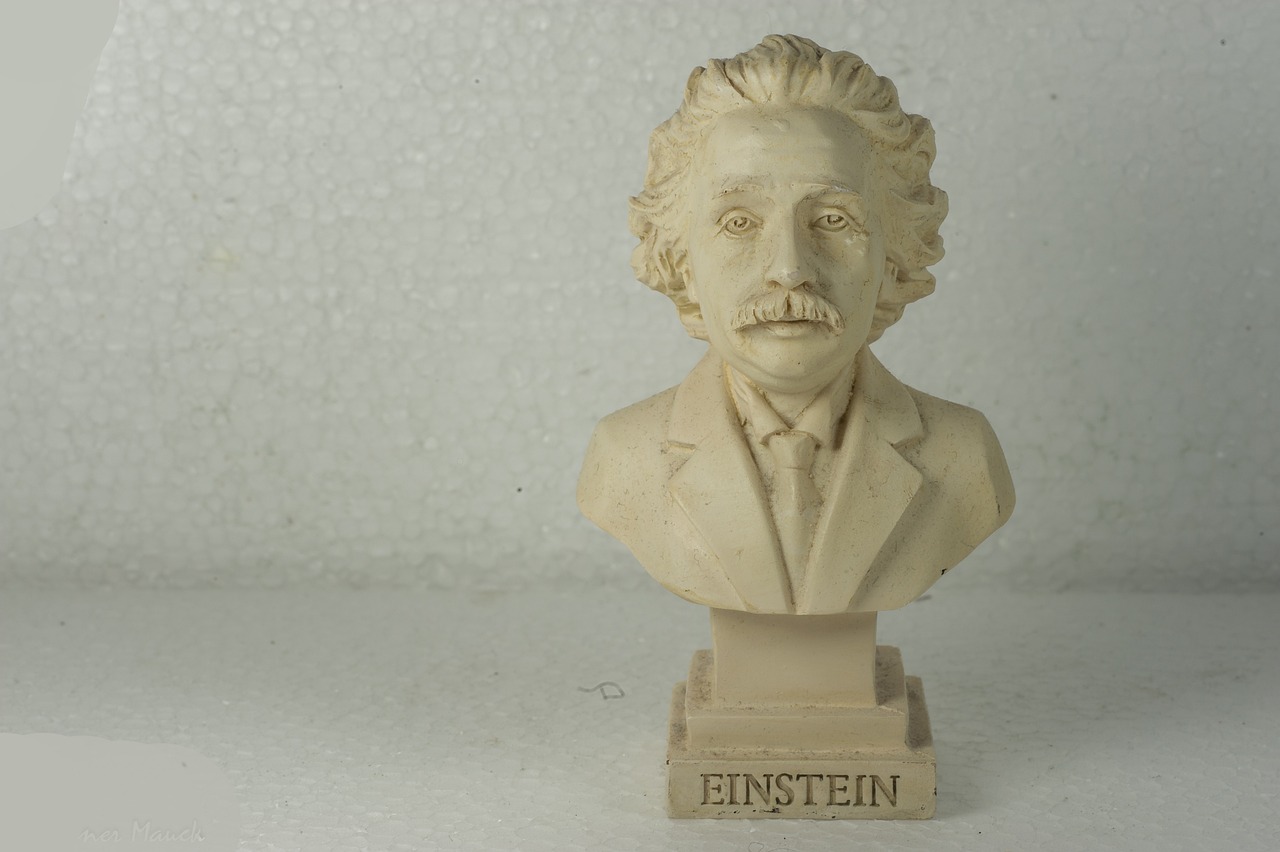
General Relativity
Einstein's general theory of relativity, published in 1915, marked a monumental shift in our understanding of the universe. Before this groundbreaking work, gravity was seen merely as a force acting at a distance, as described by Newton. However, Einstein introduced a revolutionary idea: gravity is not just a force but a curvature of space-time caused by mass. Imagine placing a heavy ball on a stretched rubber sheet; the ball creates a dip in the sheet, and any smaller balls placed nearby will roll towards the larger one due to the curvature. This analogy beautifully illustrates how massive objects like planets and stars warp the fabric of space-time around them.
One of the most astonishing implications of general relativity is the prediction of phenomena such as black holes and gravitational waves. Black holes, regions in space where gravity is so strong that nothing, not even light, can escape, were once thought to be purely theoretical. However, they have since been confirmed through various astronomical observations. Gravitational waves, ripples in space-time caused by massive accelerating objects, were detected directly for the first time in 2015, validating Einstein's predictions a century later.
General relativity has numerous applications in modern technology, most notably in the Global Positioning System (GPS). The satellites that make up the GPS network experience time differently than people on Earth due to their relative speeds and the weaker gravitational field in space. Einstein's theories help correct the discrepancies, ensuring that our navigation systems remain accurate.
To summarize the key tenets of general relativity, consider the following table:
| Concept | Description |
|---|---|
| Curvature of Space-Time | Massive objects warp space-time, affecting the motion of other objects. |
| Black Holes | Regions where gravity prevents anything from escaping, including light. |
| Gravitational Waves | Ripples in space-time caused by accelerating masses, confirmed through detection. |
| GPS Technology | Uses corrections based on relativity for accurate positioning. |
In essence, general relativity not only transformed theoretical physics but also laid the groundwork for understanding the universe's most enigmatic phenomena. It challenges us to think beyond the conventional and inspires us to explore the cosmos with a fresh perspective. Isn't it fascinating how a simple idea about gravity can lead to such profound implications? It makes you wonder what other mysteries of the universe await our discovery!
- What is general relativity?
General relativity is a theory proposed by Albert Einstein that describes gravity as a curvature of space-time caused by mass, rather than a force acting at a distance.
- How did general relativity change our understanding of gravity?
It shifted the perspective from viewing gravity as a force to understanding it as a geometric property of space-time, fundamentally altering our grasp of how objects interact in the universe.
- What are black holes?
Black holes are regions in space where gravitational forces are so intense that nothing can escape from them, including light, making them invisible and detectable only through their effects on nearby matter.
- How do gravitational waves relate to general relativity?
Gravitational waves are ripples in the fabric of space-time predicted by general relativity, resulting from the acceleration of massive objects, such as merging black holes.

Impact on Modern Physics
Albert Einstein's theories have fundamentally transformed the landscape of modern physics, acting as a catalyst for a myriad of scientific advancements and discoveries. His groundbreaking ideas about the nature of space, time, and gravity have not only redefined our understanding of the universe but have also paved the way for numerous technologies and theories that we take for granted today. Imagine a world where GPS technology, nuclear energy, and even the very fabric of our understanding of the cosmos would not exist without his contributions. It's a staggering thought!
One of the most significant impacts of Einstein's work can be traced through the evolution of cosmology, the study of the universe's origins and structure. His general theory of relativity, for instance, provided the framework for understanding the dynamics of celestial bodies and the expansion of the universe. This was a game changer, leading to the development of the Big Bang theory and our current understanding of cosmic phenomena. Today, scientists utilize Einstein's equations to explore everything from black holes to the behavior of light in gravitational fields.
Moreover, Einstein's theories have had profound implications in the realm of quantum mechanics. Although he had reservations about certain interpretations of quantum theory, his work laid essential groundwork for future physicists. For example, the photoelectric effect, which earned him the Nobel Prize in Physics in 1921, demonstrated how light behaves as both a wave and a particle. This duality is a cornerstone of quantum mechanics, influencing technologies such as semiconductors and lasers, which are integral to modern electronics.
To illustrate the breadth of Einstein's influence, consider the following table that highlights some of the key areas of modern physics impacted by his theories:
| Field | Impact |
|---|---|
| Cosmology | Foundation for the Big Bang theory and understanding of the universe's expansion. |
| Quantum Mechanics | Laid groundwork for the dual nature of light and quantum theory advancements. |
| Nuclear Physics | Mass-energy equivalence led to the development of nuclear energy and weapons. |
| Astrophysics | Insights into black holes, gravitational waves, and the behavior of light in strong gravitational fields. |
Einstein's legacy is not just confined to theoretical frameworks; it has also inspired countless researchers to delve deeper into the mysteries of the universe. His ability to think outside the conventional boundaries of physics encouraged a generation of scientists to question established norms and explore uncharted territories. This spirit of inquiry is evident in the ongoing research surrounding dark matter and dark energy, areas that remain some of the most perplexing challenges in modern physics.
In conclusion, the impact of Albert Einstein on modern physics is immeasurable. His theories not only reshaped our understanding of the universe but also ignited a wave of innovation and exploration that continues to this day. As we stand on the shoulders of giants like Einstein, we are reminded of the profound connection between theoretical physics and the technological advancements that shape our everyday lives.
- What is Einstein's most famous equation?
Einstein's most famous equation is Emc², which expresses the equivalence of mass and energy. - How did Einstein contribute to quantum mechanics?
Einstein contributed to quantum mechanics through his work on the photoelectric effect, which demonstrated the particle-like behavior of light. - What is the significance of general relativity?
General relativity revolutionized our understanding of gravity, describing it as the curvature of space-time caused by mass. - How has Einstein's work influenced technology today?
Einstein's theories have influenced technologies such as GPS, nuclear energy, and various electronic devices.

Quantum Mechanics and Einstein
Albert Einstein is often regarded as one of the greatest minds in physics, but his relationship with quantum mechanics was anything but straightforward. While he played a crucial role in the early development of this revolutionary field, his views were often at odds with the very principles he helped establish. Imagine a brilliant artist creating a masterpiece but then stepping back in confusion, questioning the very brushstrokes that defined the work. This was Einstein's dilemma with quantum mechanics.
In 1905, Einstein introduced the idea of light quanta, or photons, which was a groundbreaking concept that laid the foundation for quantum theory. His work on the photoelectric effect, for which he won the Nobel Prize in 1921, demonstrated that light can behave both as a wave and as a particle. This duality was revolutionary, challenging the classical perception of physics at the time. However, as quantum mechanics evolved, Einstein became increasingly skeptical of its implications.
Einstein famously declared, “God does not play dice with the universe,” expressing his discomfort with the inherent randomness and uncertainty that quantum mechanics proposed. He believed that the universe operated on deterministic laws, much like a well-orchestrated symphony. To him, the idea that particles could exist in multiple states at once or that their behavior could be fundamentally probabilistic was unsettling. He preferred the notion of a predictable universe, governed by clear and absolute laws.
This philosophical clash culminated in a series of debates with contemporaries like Niels Bohr, who championed the probabilistic nature of quantum mechanics. These discussions were not merely academic; they were passionate exchanges that shaped the future of physics. The famous Einstein-Bohr debates became legendary, highlighting the divide between those who embraced the uncertainties of quantum mechanics and those who sought a more classical understanding of the universe.
Despite his reservations, Einstein's contributions to quantum theory cannot be overstated. His work laid the groundwork for many modern technologies, including semiconductors and lasers. The principles of quantum mechanics have led to advancements that we rely on daily, from smartphones to medical imaging. In a way, Einstein's initial skepticism has fueled ongoing discussions and research within the field, prompting scientists to explore the very nature of reality.
To summarize Einstein's relationship with quantum mechanics, one could say it was a complex dance of admiration and skepticism. His pioneering work opened doors to new realms of understanding, yet his philosophical objections continue to provoke thought and debate among physicists even today. The interplay between Einstein's deterministic worldview and the probabilistic nature of quantum mechanics illustrates the profound challenges that come with unraveling the mysteries of the universe.
- What was Einstein's main contribution to quantum mechanics? Einstein's main contribution was the introduction of the concept of light quanta (photons) and his explanation of the photoelectric effect.
- Why did Einstein disagree with quantum mechanics? Einstein disagreed with quantum mechanics because he believed in a deterministic universe, while quantum mechanics introduced inherent randomness and uncertainty.
- What were the Einstein-Bohr debates? The Einstein-Bohr debates were a series of discussions between Einstein and physicist Niels Bohr about the interpretations and implications of quantum mechanics.

Legacy and Influence
Albert Einstein's legacy is not merely confined to his scientific achievements; it extends far into the realms of culture, philosophy, and humanitarianism. His groundbreaking work in theoretical physics has transformed our understanding of the universe, yet his influence stretches beyond the confines of academia. Einstein's ideas have permeated popular culture, inspiring countless individuals to explore the wonders of science and the mysteries of existence. He became a symbol of intellectual curiosity and a beacon for those who dare to challenge conventional wisdom.
One of the most striking aspects of Einstein's legacy is his unwavering commitment to peace and social justice. During tumultuous times, especially during World War II, he used his platform to advocate for humanitarian causes. His letter to President Franklin D. Roosevelt in 1939, warning about the potential for Nazi Germany to develop atomic weapons, exemplifies his deep concern for the ethical implications of scientific advancement. Einstein was not just a physicist; he was a global citizen who believed in using his knowledge to foster a better world.
His thoughts on peace and the responsibility of scientists resonate even today. Einstein famously stated, "Science without religion is lame, religion without science is blind." This quote encapsulates his belief that scientific inquiry and ethical considerations should go hand in hand. He urged scientists to consider the broader implications of their work, advocating for a balance between scientific discovery and moral responsibility.
Moreover, Einstein's influence can be seen in various fields beyond physics. His theories have inspired advancements in technology, such as GPS systems, which rely on principles of relativity for accuracy. The intersection of his ideas with modern technology showcases the lasting impact of his work. In education, his life story serves as a motivational tool for students, illustrating that curiosity and perseverance can lead to extraordinary achievements, regardless of one's background.
To summarize, Einstein's legacy is multifaceted. It encompasses:
- Scientific Innovation: His contributions to physics continue to shape our understanding of the universe.
- Humanitarian Advocacy: His efforts for peace and social justice remain relevant in today's global landscape.
- Cultural Icon: Einstein has become a symbol of intelligence and creativity in popular culture.
In conclusion, Albert Einstein's influence is profound and enduring. His life and work remind us that science is not just about equations and theories; it's about understanding our place in the universe and using that knowledge to improve the human condition. As we continue to grapple with the ethical dilemmas posed by scientific advancements, Einstein's legacy serves as a guiding light, urging us to strive for a better world.
- What are Einstein's most significant contributions to physics?
Einstein is best known for his theories of special relativity and general relativity, which revolutionized our understanding of space, time, and gravity. His mass-energy equivalence formula, Emc², is also one of the most famous equations in physics.
- How did Einstein's views on religion and science differ?
Einstein believed that science and religion should coexist and complement each other. He saw science as a way to understand the universe while considering the ethical implications of scientific discoveries.
- What impact did Einstein have on modern technology?
Einstein's theories have had a significant impact on modern technology, particularly in fields like GPS, telecommunications, and nuclear energy. His work laid the foundation for many technological advancements that we rely on today.
- How is Einstein remembered today?
Einstein is remembered as one of the greatest scientific minds in history. His image and ideas continue to inspire people around the world, making him a cultural icon synonymous with genius and innovation.
Frequently Asked Questions
- What inspired Albert Einstein to pursue physics?
From a young age, Einstein was captivated by the mysteries of the universe. His early exposure to science and mathematics, combined with a natural curiosity, fueled his passion for understanding the fundamental laws of nature. It was this drive that led him to explore theoretical physics, ultimately changing our perception of reality.
- How did Einstein's theory of relativity change the scientific landscape?
Einstein's theory of relativity, particularly special relativity, challenged long-held beliefs about space and time. It introduced groundbreaking concepts like time dilation and the idea that the speed of light is a constant. This revolutionized not just physics but also our understanding of the universe, paving the way for modern scientific advancements.
- What is time dilation, and why is it important?
Time dilation is a phenomenon where time passes at different rates depending on relative speeds or gravitational fields. For instance, astronauts on a high-speed journey would age more slowly than people on Earth. This concept is crucial for technologies like GPS, which must account for these differences to provide accurate positioning.
- Can you explain the mass-energy equivalence formula, Emc²?
Einstein's iconic equation Emc² expresses the idea that mass and energy are interchangeable. This means that a small amount of mass can be converted into a large amount of energy, which is the principle behind nuclear reactions. This groundbreaking insight laid the groundwork for advancements in both energy production and theoretical physics.
- What is general relativity, and how does it differ from special relativity?
General relativity, published in 1915, expands upon special relativity by incorporating gravity into the framework. While special relativity deals with objects moving at constant speeds in a straight line, general relativity describes gravity as the curvature of space-time caused by mass. This theory fundamentally altered our understanding of cosmic phenomena.
- How did Einstein's work influence modern physics?
Einstein's theories have had a profound impact on various fields, including cosmology, astrophysics, and quantum mechanics. His ideas have inspired countless researchers and have become foundational in our quest to understand the universe, influencing everything from black holes to the expansion of the cosmos.
- What were Einstein's views on quantum mechanics?
Although Einstein made significant contributions to quantum theory, he famously expressed skepticism about its implications, particularly the concept of entanglement. His debates with contemporaries like Niels Bohr sparked ongoing discussions about the nature of reality and have shaped the field of quantum mechanics to this day.
- What is Einstein's legacy beyond science?
Einstein's legacy is not just confined to his scientific achievements; he was also a passionate advocate for peace, civil rights, and humanitarian efforts. His belief in the responsibility of scientists to engage with global challenges continues to inspire generations, reminding us of the vital role science plays in society.

